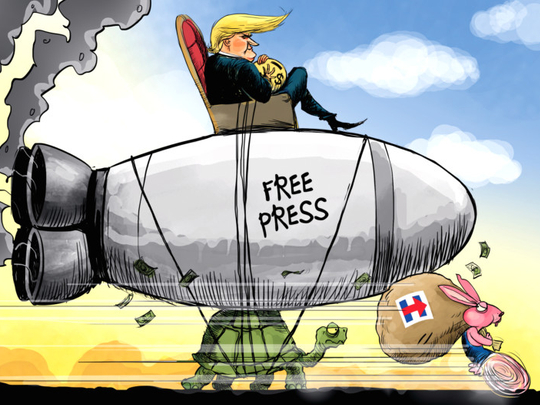
The conventional wisdom is that it takes somewhere between $1 billion (Dh3.67 billion) and $1.5 billion to run a serious campaign for the American presidency. No one knows this for certain, of course, it is simply the way things have always been done (though, obviously, the size of the required campaign war chest has grown over time).
This year, however, it appears the theory will be tested. Donald Trump clearly plans to spend far, far less on his campaign than Hillary Clinton; pinning his hopes on the idea that what professionals call “free media” — interviews with the candidate and TV coverage of his rallies — will offset hundreds of millions of dollars in TV ads, fundraising and basic organisational work.
For the last two weeks or so, Democrats in the United States have been giddy at the news that Hillary’s campaign finished May with $42 million in the bank compared to only $1.3 million for Trump. During that same month, her campaign outraised his by a margin of nearly 9-1. (Trump dismissed the comparison as meaningless and promptly donated several million more of his own money to his campaign).
The disparity goes beyond mere money. Hillary’s campaign employs nearly 800 people. Trump’s, until a few weeks ago, had about 70 (it has reportedly hired more in recent days). Put another way: Trump’s entire paid staff nationwide is about half the number of interns working at Hillary’s campaign headquarters in Brooklyn.
When he first got into the presidential race last year, Trump told CNN that he was prepared to spend $1 billion of his own money if that was what it took to win the presidency, but in the months since, he has openly questioned the logic behind that number. “I don’t understand, as a businessperson, how it’s possible to spend all of this money,” he told Bloomberg News in May. In that interview, Trump speculated that $500 million would be enough to win the White House.
During the primaries, Trump largely eschewed advertising and meticulous voter-targeting efforts in favour of large rallies and the belief that the enthusiasm generated there, combined with a lot of free media, would carry him through on Election Day. Making a similar strategy work in November requires two very specific things.
First, he will need the TV networks to continue giving him the sort of blanket coverage they did throughout the winter and spring: Airing long sections of his rallies live almost every day and putting him on the air for interviews pretty much any time he chooses to call into a TV news show.
Wild off-the-cuff remarks
The problem with this theory is that most US TV channels will try to balance their coverage of Trump and Hillary through the autumn campaign. Giving most of your political airtime to the frontrunner because he has a habit of making wild off-the-cuff remarks might be editorially justifiable in a crowded primary field, but, viewed from a newsroom, general elections are different. Trump might get all the free media he craves on the theory that if Hillary wants to call into the morning news shows she is equally free to do so, but he would be foolish to bank on it. If tradition holds, he will not dominate September and October’s airwaves the way he dominated February and March.
Second, the Trump campaign will, largely of necessity, test the theory that television advertising is an essential part of how a candidate frames his or her message to the voting public. Over the last few months a number of media outlets have reported that much of the advertising space on local television stations in battleground states is already booked. If that is true (and the reports are difficult to confirm) Trump may find it hard to buy time in the key final weeks of the campaign.
Of course, just because generations of American politicos have believed that winning elections requires hundreds of millions of dollars in advertising and an army of staff and volunteers making phone calls and knocking on doors does not make it so. During that May interview, Trump reminded the Bloomberg reporters that he had just beaten 17 opponents while spending only “$45 million. That was over a period of a year”. In a year that has tested, and dismantled, many assumptions about the way American campaigns work it would be unwise simply to write Trump off.
Yet, it is also true that things have been done a certain way for generations because certain things have been shown to work. Americans get a lot of their information from television, which is why advertising is believed to be crucial. Because turnout in US elections is fairly low by global standards, all those volunteers and staff are needed to make sure people actually bother to vote. All this costs a lot of money — hence the relentless fundraising.
Ideology aside, the coming months will see a huge clash between competing theories of political organisation, with America’s future hanging on the question of which approach actually works.
Gordon Robison, a longtime Middle East journalist and US political analyst, teaches political science at the University of Vermont.








